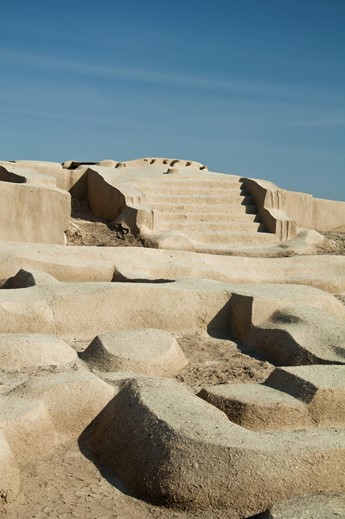Using Isotope Geochemistry to Investigate Migration Patterns and Diet of Past Civilizations
Author: Maren Pauly, Account Manager, Isobar Science

Shahr-e Soukhteh (The Burnt City) in SE Iran, initiated around 3200 BC and abandoned in 1800 BC. (Photo Credit: Arash Sharifi, VP of Lab Operations, Isobar Science).
The migration patterns of past civilizations are very important in understanding the causes and consequences of cultural transfer and change (Burnmeister, 2016). Often migration dynamics are mapped based on how archaeological finds are distributed through space. However, integrating multidisciplinary evidence, through the use of stable isotopes can provide extensive evidence on migration lifestyle and civilization integration beyond qualitative artefact assessment alone.
Oxygen isotope (δ18O) of precipitation can be used to pinpoint the source of drinking water (e.g. Serna et al. 2020) as the isotopic signature of oxygen in rain and snow (H2O) varies according to geographic location and elevation (Dansgaard 1964). Regional maps of precipitation isotopes can be used to validate recent locations or movement of populations. Nitrogen isotopic ratios (δ15N) within food consumed is integrated into the tissues of humans and animals (e.g. Blanz et al. 2020; Bogaard et al. 2007), providing the opportunity to hypothesize the diet composition (e.g. carnivore/omnivore, herbivores; Sponheimer et al. 2003) and even provide evidence of a population’s predominant lifestyle (hunter-gatherer or agricultural societies; Itahashi et al. 2017).
Strontium (Sr) and lead (Pb) isotope compositions can be tied to specific regions due to local geological signatures, which are integrated into the soil and water through the erosion of rock and eventually incorporated into vegetation (e.g. Porder et al. 2003). When vegetation and water containing these elements are consumed, the Sr can replace the calcium in the bone and Pb can enter into the mineralized structure of the bone (e.g. Pemmer et al. 2013). Additionally, Pb can be directly integrated into the system through breathing in local dust. As such, tissues of humans and animals living within a certain area will contain specific Sr and Pb isotopic ratios through water and food consumption, which can tie them to their home region (e.g. Sealy et al. 1991; Schweissing et al. 2003).
There are many different ways stable isotopes can be used to track the location of prehistoric skeletons and interpret migration patterns and pinpoint diet to certain sources/regions. The best option for the site in question depends on the availability of isotopic information in the excavation region as the local isotopic ranges within precipitation and geology may be more or less certain depending on the amount and quality of data available within regional databases.
Recently, multi-isotope studies (Pb, Sr, O, N) have been employed to deliver several, independent lines of evidence, confirming or ruling out geolocation theories of one isotope measurement alone. Modern advancements in stable and radiogenic isotopic analysis can be readily applied to archaeological studies, providing archaeologists with novel tools to investigate migration and dietary details about the past societies, beyond the traditional archaeological approaches alone.
References
Blanz, M., Mainland, I., Richards, M., Balasse, M., Ascough, P., Wolfhagen, J., Taggart, M.A. and Feldmann, J., 2020. Identifying seaweed consumption by sheep using isotope analysis of their bones and teeth: Modern reference δ13C and δ15N values and their archaeological implications. Journal of Archaeological Science, 118, p.105140.
Bogaard, A., Heaton, T.H., Poulton, P. and Merbach, I., 2007. The impact of manuring on nitrogen isotope ratios in cereals: archaeological implications for reconstruction of diet and crop management practices. Journal of Archaeological Science, 34(3), pp.335-343
Burmeister, S. (2016). Archaeological research on migration as a multidisciplinary challenge.
Dansgaard, W., 1964. Stable isotopes in precipitation. Tellus, 16(4), pp.436-468.
Itahashi, Y., Miyake, Y., Maeda, O., Kondo, O., Hongo, H., Van Neer, W., Chikaraishi, Y., Ohkouchi, N. and Yoneda, M., 2017. Preference for fish in a Neolithic hunter-gatherer community of the upper Tigris, elucidated by amino acid δ15N analysis. Journal of Archaeological Science, 82, pp.40-49.
Pemmer, B., Roschger, A., Wastl, A., Hofstaetter, J.G., Wobrauschek, P., Simon, R., Thaler, H.W., Roschger, P., Klaushofer, K. and Streli, C., 2013. Spatial distribution of the trace elements zinc, strontium and lead in human bone tissue. Bone, 57(1), pp.184-193.
Porder, S., Paytan, A. and Hadly, E.A., 2003. Mapping the origin of faunal assemblages using strontium isotopes. Paleobiology, 29(2), pp.197-204.
Schweissing, M.M. and Grupe, G., 2003. Stable strontium isotopes in human teeth and bone: a key to migration events of the late Roman period in Bavaria. Journal of archaeological science, 30(11), pp.1373-1383.
Sealy, J.C., van der Merwe, N.J., Sillen, A., Kruger, F.J. and Krueger, H.W., 1991. 87Sr86Sr as a dietary indicator in modern and archaeological bone. Journal of Archaeological Science, 18(3), pp.399-416.
Serna, A., Prates, L., Valenzuela, L.O. and Salazar-García, D.C., 2020. Back to the bases: Building a terrestrial water δ18O baseline for archaeological studies in North Patagonia (Argentina). Quaternary International, 548, pp.4-12
Sponheimer, M., Robinson, T., Ayliffe, L., Roeder, B., Hammer, J., Passey, B., West, A., Cerling, T., Dearing, D. and Ehleringer, J., 2003. Nitrogen isotopes in mammalian herbivores: hair δ15N values from a controlled feeding study. International Journal of Osteoarchaeology, 13(1‐2), pp.80-87.
